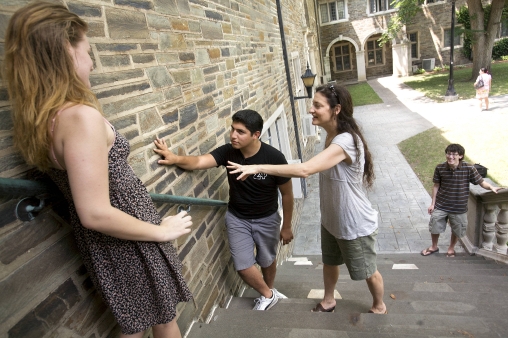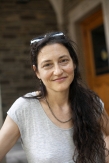ARTS AND HUMANITIES
Creative space: Faculty arts projects engage through connection of research and performance

Theater professor Beth Milles rehearses an outdoor production of Chekhov's "The Cherry Orchard" on campus with students during the summer.
Associate professor of music and pianist Xak Bjerken has organized major festivals and symposiums on campus over the past decade, exploring music from behind the Iron Curtain, 20th-century performance practice, and the works of Stravinsky and Messiaen.
Participants and audiences have enjoyed events such as "Schoenberg's Playlist" – a four-day festival in January 2011 with lectures by musicologists and Bjerken's students and guest artists performing early 20th-century piano works.
"Special projects provide opportunities to view known works in a new light, partly because of the context we create, but also in the preparatory research done for the events," Bjerken says. "There is the possibility for research and performance to shine a light on each other."
Bjerken is among a number of faculty who connect their creative endeavors in the arts with collaborative research, classroom work and student participation.

Xak Bjerken See larger image
Cornell enables cross-disciplinary collaboration on such projects, stressing theory and practice as part of a liberal arts education. The Cornell Council for the Arts also provides support for some projects.
Professor of theater Beth Milles brings her research interests in performance practices to the classroom and to her creative work. Her latest projects will involve nontraditional performance spaces, including an outdoor production of Chekhov's "The Cherry Orchard" on campus in September.
"I was very inspired by the Society for the Humanities focal theme this year and the exploration of sound," Milles says. "I love directing outdoor theater, because I can't control it – the periphery, the natural sounds and rhythms of people walking to class, and yelling, and the ebb and flow of distraction and focus. I'm interested in how the students will engage the intersection of the audience, the peripheral and performance."
She also is developing a "Russian clown piece" with her longtime collaborator, Cirque du Soleil clown Daniel Passer, who has "led several workshops with our students over the years," Milles says. There will be opportunities for students to be involved as actors in the collaboration, she says.
"We're planning to go to Russia next fall to perform the piece, [which is] inspired by the work of Charlie Chaplin and the physical desperation – and pathos – of silent films," Milles says. "A lot of my work is hybridization – commedia dell'arte is very physical. It's not just acrobatics, it's also theater, and apocalypse, and installation. There's a mystical power in moment-to-moment comedy that is created from objects. In this piece, the actual empty theater is the object."

Beth Milles
See larger image
Milles previously worked in television and film in Los Angeles, and is now in the early stages of developing a television show with a writer/collaborator in Los Angeles.
Senior lecturer in film and filmmaker Marilyn Rivchin says she has "done an enormous amount of collaborative work with colleagues, dancers and composers" at Cornell, and has produced documentaries for the Cornell Prison Education Program, Southern Tier AIDS Project and other agencies.
She also has worked with scientists. For a 2005 research collaboration with physicist Jane Wang, Rivchin filmed dragonflies on her pond and incorporated laboratory footage shot at 1,000 to 2,000 frames per second and Wang's simulations.
"They've been around for millions of years – they've survived because of how they can move," Rivchin says. "Jane was making some interesting breakthroughs and that's what interested me."
Students in her documentary workshop class last spring produced short films and contributed to the Cornell Genetic Ancestry Project, a collaboration with Professor Charles Aquadro and visiting professor Spencer Wells.
Rivchin spent 18 months creating a triple projection for a 2009 Cornell production at the Schwartz Center of Leonard Bernstein's "Mass," co-directed by Professor (and then-Schwartz Center artistic director) David Feldshuh and Scott Tucker, director of choral music; and, inspired by paintings and drawings by former landscape architecture professor Amaechi Okigbo, contributed to "Planes," a dance choreographed by senior lecturer Jumay Chu.
"He let me create animated multiple projections with his imagery, synched with four moving screens and dancers," Rivchin says. "That was a wonderful collaboration."
Department of Theatre, Film and Dance design staff and alumna dancer Nadia Drake participated in Rivchin's 2008 art installation "Chute," with images projected onto a parachute suspended in the Schwartz Center lobby.
This fall, Rivchin will co-teach Synergies of Audio and Video, a digital media studies course that ties in with the Society for the Humanities' 2011-12 focal theme, "Sound: Culture, Theory, Practice, Politics," and is creating work for director Melanie Dreyer-Lude's staging next spring of the experimental play "Long Ago in May."
"One of the advantages of the diversity of expertise in our and other departments is it is very exciting to be able to create new work," Rivchin says. "People who are experts in different fields don't often get the chance to work together so directly."
Bjerken says his projects provide him and his colleagues with "a forum to get together in a looser context than is possible in our usual day-to-day teaching and lonely research lives. And there is a social aspect … bringing people together to make connections both intellectually and in experiencing something really exceptional."
His next venture, "Look and Listen," will showcase Cornell's composition program in a series of musical installations celebrating the Oct. 30 opening of the Johnson Museum's new wing. Music performance faculty and graduate student musicians will premiere compositions written for the occasion by Cornell composers, "reflecting specific works [and] areas of the museum, wrapping up with a group improv on the fifth floor," Bjerken says.